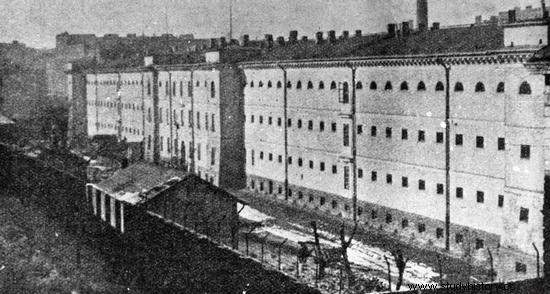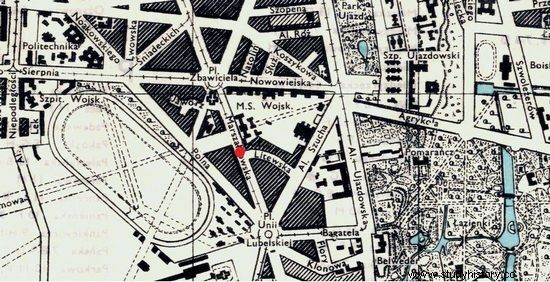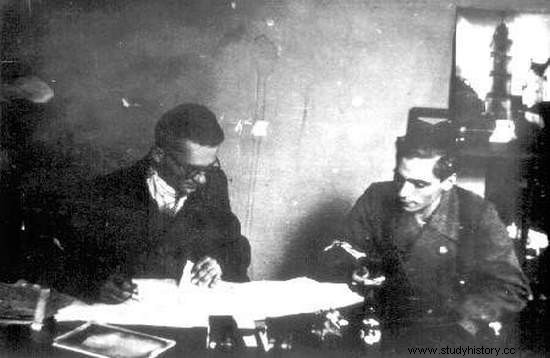Pawiak occupied a special place on the map of Warsaw during the occupation. Over 90,000 people passed through the walls of the prison. Half of them did not live to see the end of the war. Many brutal guards worked in the Gestapo torture room, but one of them was an exceptional sadist. Therefore, the Home Army decided that it must die first.
The SS officer in question was SS-Oberscharführer Franz Bürkl. He came to Pawiak in 1941 and initially was the deputy commander of the prison. After some time, however, he was relegated to the position of a senior watchman. It is difficult to say unequivocally what caused such a turn of events. There are many indications that this was due to the insubordination and special brutality of the degenerate - exceeding even Gestapian standards.
The Pawiak Beast
Franz Bürkl had a huge number of crimes to his credit. Probably he was the first to start killing prisoners during interrogations . It was often motivated by the sheer desire to steal valuable items belonging to the victims.
There were also situations in which the superiors were dismayed to discover that the person who was the subject of the investigation was dead, although no one had ordered her to be killed. It was unthinkable in the bureaucratic German death machine.

The prison in Pawiak during the German occupation was a threat to every inhabitant of Warsaw. Over 90 thousand people passed through its walls. people. Half of them were tortured on the spot, executed in public executions or murdered in concentration camps.
As if that were not enough, Oberscharführer he did not limit himself to murdering prisoners. He happened to kill random passers-by in Warsaw's streets for pure pleasure! No wonder then that the Polish Underground State decided in 1943 to send the criminal to the afterlife. The "Agat" (anti-Gestapo) combat diversion unit of the Kedyw of the Home Army Headquarters was appointed to carry out the attack.
What is this Bürkl like?
Of course, the first thing to do was to observe the target. This was entrusted to the head of the unit's intelligence, Aleksander Kunicki "Rayski". The problem, however, was that the Home Army had virtually no information about Bürkel's appearance and private life.
Not even a photo was available to identify him! All it was known was that he had an aggressive German Shepherd Dog - named Kastor - which he gladly pounced on helpless victims.
Therefore, Kunicki decided that the only reasonable solution would be to follow the SS men on the route from Pawiak to the Gestapo building on Aleja Szucha and further to the German district. He hoped this would at least set the schedule for their day. With a bit of luck, you might even get on the trail of Oberscharführer - after all, how many SS men could have had a bad wolfhound?
Indeed, after a few days, "Rayski" selected a guard who might be who he was looking for. But that was still not enough. He needed 100 percent certainty. He had to find someone who had seen Bürkel with his own eyes. Fortunately, one of his colleagues put him in touch with Bogusław Ustaborowicz "Żar", who had recently left Pawiak.
Thanks to the information provided by the young soldier, it was possible to say that Oberscharführer lives at ul. Polna 22. This in turn made it possible to undertake a large-scale observation.

The site of the planned assassination, marked on the inter-war map of Warsaw.
Thanks to it, it was established that the SS man leaves his apartment at 10 am and reaches the Gestapo building on foot, from where he drives to Pawiak by car at 12.45. As Piotr Stachiewicz writes in the book "» Parasol ". The history of the Division for Special Tasks of the Diversion Management of the Home Army Headquarters ":
The interview cycle started when there was no news about Bürkel and it was closed with his appearance ( medium height, strong stocky, face with olive complexion, southerly type, eagle nose . Dressed in an SS uniform, a diamond with the letters SD on the left sleeve) .
"Jeremi" takes the baton
Once the initial reconnaissance was complete, the contractors for Operation Bürkl had to be selected. The choice fell on the 1st platoon, commanded by Jerzy Zborowski "Jeremy". Together with his men, he took over the further surveillance of the German criminal.
It lasted as long as three weeks and focused on precisely determining his plan of the day and selecting the place where the attack will be made. Ultimately, the crossing of Oleandrów, Marszałkowska and Litewska Streets was selected. It was still necessary to decide how to carry out the whole action.
Two concepts emerged. The first of them considered an attack with a strong unit that would bind the Germans in a fight. The second one was limited to a small group, carrying out a lightning attack, ending with a quick jump away. "Jeremi" - as he explained in his report - finally stated that:
Due to the specific conditions of the selected area (German district, 200 m from Aleja Szucha, nearby houses inhabited by Gestapo and police officers, heavy traffic of the police, Gestapo, motorcycle patrols and cars, etc.) and the related difficulty of disguising the preparations for the action, I decided to use a small team for the action who would be extremely flexible in command, flexible and agile in combat, and would be able to take actions and withdraw very quickly. The team consisted of 5 people, including me and the chauffeur.
Now it was only necessary to collect the previously prepared submachine guns, grenades and handguns and wait for the order to attack. The commander of "Pegasus", Adam Borys "Pług", appointed him on Tuesday, September 7, 1943.
Liquidation of the criminal
Unfortunately, it was not without problems. When the day of the assassination finally came, the driver who was supposed to take the Home Army soldiers after the whole action did not show up at all. Fortunately, a spare car was taken care of in advance. But that wasn't the biggest problem with "Jeremy" at all.

A handwritten sketch of Jerzy Zborowski "Jeremy", made after the action "Bürkl".
When at 9:48 am, "Żar" accompanying the attackers, he pointed out Oberscharführer leaving the tenement house at 22 Polna Street. , Zborowski was literally speechless. This was not the man who was going to be liquidated! Are you wondering how it is even possible? This is how Piotr Stachiewicz explained it in his book:
As a result of some mistake - difficult to establish today - when Bürkel was repeatedly handed over to the detachment by interview, then within the detachment by individual observers to one another, another German was observed at the last stage of observation .
The error is understandable as several SS men working as guards in Pawiak lived in the tenement house at 22 Polna Street. Fortunately, thanks to the fact that Ustaborowicz was there, a compromising mistake was avoided.
After a moment's hesitation, "Jeremi" decided that he would trust the former prisoner of Pawiak. After all, who, if not he, was supposed to know what Bürkl looks like? Ustaborowicz fulfilled his task and the real Bürkel was located in the blink of an eye. The fate was favorable to the attackers:apart from the mistakenly followed officer, the building was also abandoned by the murderer, who was sentenced to death.
Now everything happened very quickly. Together with Bronisław Pietraszewicz "Lot" they quickly approached Bürkel from behind and opened fire on him at the same time. The SS man fell to the ground dead . Everything was going according to plan.

Jerzy Zborowski "Jeremi" (with glasses). It was he who commanded the liquidation of executioner Pawiak.
Only Mrs Bürkl, who unexpectedly accompanied her husband that day, was a problem. Regardless of the guns aimed at her, she lunged at "Lot", severely scratching his face and hands as he inspected the SS man's body.
At the same time, the alarmed Germans started shooting at the attackers. The Poles responded with accurate fire from machine guns. Several dead policemen and SS men fell on the pavement. It was a signal that it was time to leave.
The spare driver, borrowed from the "Zośka" battalion, did a great job. Despite a strong enemy cannonade, he managed to take all the participants of the attack and safely leave the place of action. The entire match lasted only 90 seconds!
His balance sheet was extremely successful. As Tomasz Strzembosz emphasizes in his book "Akcje Zbrojne Podznej Warszawy 1939-1944":
Bürkel and seven to nine other Germans were shot , at least a few were injured. And - despite extremely unfavorable conditions - own losses were not .
Equally important - if not more important - was the psychological effect. The German torturers stopped feeling safe. And they had reasons for it. Agat will target many more of them, but that's a topic for future articles.
